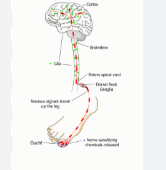Unveiling the Hidden Origins: What Is the Root Cause of Fibromyalgia?
Unveiling the Hidden Origins: What Is the Root Cause of Fibromyalgia?
Fibromyalgia is a complex and often misunderstood condition characterized by widespread musculoskeletal pain, fatigue, sleep disturbances, and cognitive difficulties. Despite extensive research, the exact root cause of fibromyalgia remains elusive. However, several interrelated factors have been identified that contribute to the development and persistence of this chronic disorder.
Central Sensitization: The Core Mechanism
At the heart of fibromyalgia lies a phenomenon known as central sensitization. This refers to an increased sensitivity of the central nervous system (CNS) to pain stimuli. In individuals with fibromyalgia, the CNS amplifies pain signals, leading to heightened pain perception even in response to non-painful stimuli. This abnormal pain processing is believed to result from changes in how the brain and spinal cord interpret and respond to sensory information.
Genetic Predisposition and Familial Patterns
Genetic factors play a significant role in fibromyalgia. Studies have shown that the condition tends to run in families, suggesting a hereditary component. Specific gene variants may influence how individuals process pain and respond to stress, making them more susceptible to developing fibromyalgia. However, genetics alone do not account for the condition, indicating that environmental factors also contribute.
Immune System Involvement
Recent research has highlighted the potential role of the immune system in fibromyalgia. Some studies suggest that autoantibodies—antibodies that mistakenly target the body’s own tissues—may contribute to the symptoms by affecting nerve function. This autoimmune response could lead to increased pain sensitivity and other characteristic features of fibromyalgia.
Neurotransmitter Imbalances
Neurotransmitters are chemical messengers that transmit signals between nerve cells. In fibromyalgia, imbalances in neurotransmitters such as serotonin, dopamine, and norepinephrine have been observed. These imbalances can affect mood, sleep, and pain perception, all of which are commonly disrupted in individuals with fibromyalgia.
Sleep Disturbances and Their Impact
Sleep problems are both a symptom and a potential contributing factor in fibromyalgia. Individuals with the condition often experience non-restorative sleep, which can exacerbate pain and fatigue. Disrupted sleep patterns may interfere with the body’s ability to regulate pain and stress responses, creating a cycle that perpetuates fibromyalgia symptoms.
Psychological and Emotional Stressors
Chronic psychological stress and emotional trauma have been linked to the onset and exacerbation of fibromyalgia. Stress can alter the functioning of the hypothalamic-pituitary-adrenal (HPA) axis, a system that regulates stress responses. Dysregulation of the HPA axis may contribute to the development of fibromyalgia by affecting pain sensitivity and immune function.
Infections and Physical Trauma
Certain infections and physical injuries have been identified as potential triggers for fibromyalgia. For example, infections like Epstein-Barr virus or Lyme disease, as well as traumatic events such as car accidents, may initiate the onset of symptoms in predisposed individuals. These events can act as stressors that disrupt normal physiological processes, leading to the development of fibromyalgia.
Gut Microbiome Alterations
Emerging evidence suggests that changes in the gut microbiome—the community of microorganisms residing in the digestive tract—may be associated with fibromyalgia. Alterations in gut bacteria composition could influence inflammation and pain perception, although more research is needed to fully understand this connection.
Conclusion While the exact root cause of fibromyalgia remains uncertain, it is clear that the condition arises from a combination of factors involving the central nervous system, genetic predispositions, immune responses, neurotransmitter imbalances, sleep disturbances, psychological stressors, infections, physical trauma, and possibly gut microbiome alterations. Understanding these interconnected elements is crucial for developing effective treatment strategies and improving the quality of life for those affected by fibromyalgia



